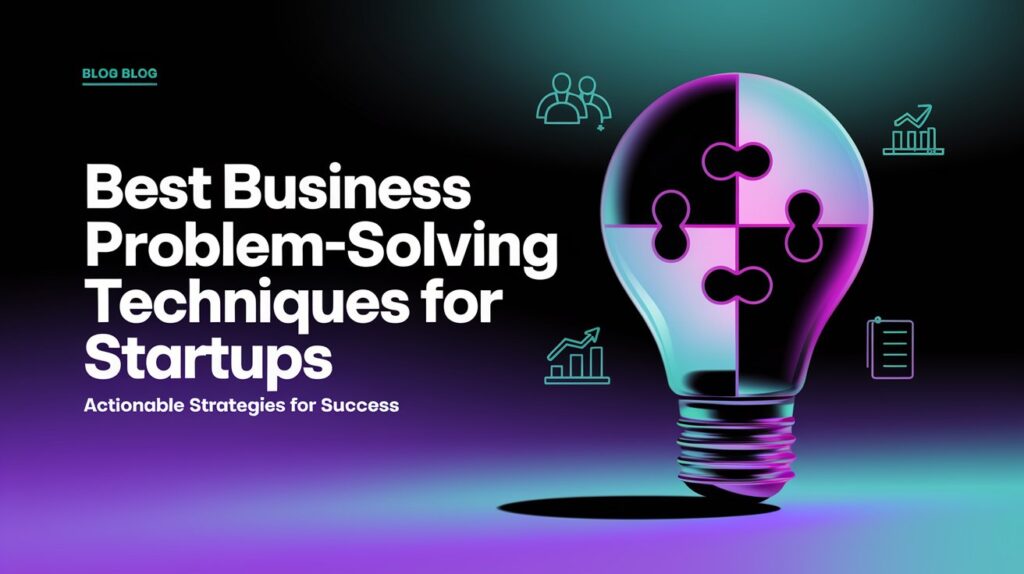Best Business Problem-Solving Techniques For Startups
Starting a business is an exciting journey, but it’s also filled with challenges and obstacles. For startups, the ability to solve problems effectively can mean the difference between success and failure. Problem-solving is not just about fixing issues as they arise; it’s about anticipating challenges, developing strategies to overcome them, and fostering a culture of innovation and resilience.
In this blog, we’ll explore the best business problem-solving techniques for startups, drawing insights from industry experts and proven methodologies. Whether you’re a first-time entrepreneur or a seasoned business owner, these techniques will help you navigate the complexities of running a startup and turn challenges into opportunities.
Why Problem-Solving Skills Are Crucial for Startups
Before diving into specific techniques, it’s important to understand why problem-solving is so critical for startups:
-
Startups Operate in Uncertainty: Unlike established businesses, startups often lack resources, data, and experience. This makes them more vulnerable to unexpected challenges.
-
Resource Constraints: Startups typically operate with limited budgets, manpower, and time. Effective problem-solving ensures that these resources are used efficiently.
-
Innovation is Key: Startups thrive on innovation. Problem-solving fosters creativity and helps businesses find unique solutions to stand out in competitive markets.
-
Customer-Centric Approach: Solving problems effectively ensures that startups can meet customer needs and build long-term relationships.
Now, let’s dive into the best problem-solving techniques that startups can use to overcome challenges and achieve success.
1. Define the Problem Clearly
The first step in solving any problem is to define it clearly. Many startups fail to address issues effectively because they don’t fully understand the problem they’re facing. Here’s how to define a problem:
Ask the Right Questions: What is the root cause of the issue? Who is affected by it? What are the potential consequences if it’s not resolved?
Use Data and Feedback: Gather data from customers, employees, and stakeholders to gain a comprehensive understanding of the problem.
Avoid Assumptions: Don’t jump to conclusions. Take the time to analyze the situation objectively.
For example, if your startup is experiencing a decline in sales, don’t assume it’s due to poor product quality. Instead, investigate factors like pricing, marketing strategies, or customer preferences.

2. Adopt a Structured Problem-Solving Framework
Using a structured framework can help startups approach problems systematically. One of the most effective frameworks is the 5 Whys Technique:
Ask “Why” Repeatedly: Start with the problem and ask “why” it occurred. Repeat this process five times (or more) to drill down to the root cause.
Example:
Problem: Sales have dropped.
Why? Customers are not returning.
Why? The product doesn’t meet their expectations.
Why? The product features are outdated.
Why? We haven’t conducted market research in a year.
Why? We prioritized other tasks over customer feedback.
By the fifth “why,” you’ll likely identify the root cause and can develop targeted solutions.
3. Leverage Design Thinking
Design thinking is a human-centered approach to problem-solving that emphasizes empathy, creativity, and experimentation. It’s particularly useful for startups because it encourages innovative solutions. Here’s how to apply design thinking:
Empathize: Understand the problem from the customer’s perspective. Conduct interviews, surveys, and observations to gather insights.
Define: Clearly articulate the problem based on your findings.
Ideate: Brainstorm a wide range of potential solutions without judgment.
Prototype: Create a simple, low-cost version of your solution to test its feasibility.
Test: Gather feedback from users and refine your solution.
For example, if your startup is developing a new app, use design thinking to ensure the product meets user needs and solves real problems.

4. Use SWOT Analysis
A SWOT analysis is a strategic tool that helps startups identify their strengths, weaknesses, opportunities, and threats. It’s particularly useful for problem-solving because it provides a holistic view of the business environment.
Strengths: What advantages does your startup have? (e.g., skilled team, innovative product)
Weaknesses: What areas need improvement? (e.g., limited funding, lack of brand awareness)
Opportunities: What external factors can you leverage? (e.g., emerging markets, partnerships)
Threats: What challenges could hinder your success? (e.g., competition, regulatory changes)
By conducting a SWOT analysis, startups can identify potential problems and develop strategies to address them proactively.
5. Embrace Agile Methodology
Agile methodology is a project management approach that emphasizes flexibility, collaboration, and iterative progress. It’s highly effective for startups because it allows them to adapt quickly to changing circumstances.
Break Problems into Smaller Tasks: Divide complex problems into manageable tasks and tackle them one at a time.
Iterate and Improve: Continuously test and refine your solutions based on feedback.
Collaborate: Encourage cross-functional teamwork to generate diverse perspectives and ideas.
For example, if your startup is developing a new product, use agile methodology to release a minimum viable product (MVP) and gather user feedback before making further improvements.
6. Foster a Problem-Solving Culture
A startup’s success depends on its team’s ability to solve problems collectively. Here’s how to foster a problem-solving culture:
Encourage Open Communication: Create an environment where team members feel comfortable sharing ideas and concerns.
Promote Collaboration: Encourage cross-departmental collaboration to leverage diverse skills and perspectives.
Reward Innovation: Recognize and reward employees who come up with creative solutions.
Provide Training: Equip your team with problem-solving tools and techniques through workshops and training programs.
For example, Google is known for its culture of innovation, where employees are encouraged to spend 20% of their time on passion projects that could benefit the company.
7. Use Data-Driven Decision Making
Data is a powerful tool for problem-solving. Startups can use data to identify trends, measure performance, and make informed decisions. Here’s how to leverage data:
Collect Relevant Data: Use tools like Google Analytics, CRM software, and surveys to gather data.
Analyze the Data: Look for patterns and insights that can help you understand the problem.
Make Informed Decisions: Use the data to develop evidence-based solutions.
For example, if your startup is struggling with customer retention, analyze customer behavior data to identify common pain points and address them.
8. Learn from Competitors
Competitors can be a valuable source of inspiration and learning. Analyze how other businesses in your industry solve similar problems and adapt their strategies to your startup.
Conduct Competitor Analysis: identify your competitors’ strengths and weaknesses.
Benchmark Best Practices: Learn from their successes and failures.
Differentiate Your Approach: Use the insights to develop unique solutions that set your startup apart.
For example, if a competitor’s marketing strategy is highly effective, analyze its key components and adapt them to your brand.
9. Prioritize Problems
Not all problems are equally important. Startups must prioritize issues based on their impact and urgency. Here’s how to prioritize effectively:
Use the Eisenhower Matrix: categorize problems into four quadrants:
Urgent and important
Important but not urgent
Urgent but not important
Neither urgent nor important
Focus on High-Impact Problems: Address issues that have the greatest impact on your business goals.
For example, if your startup is facing cash flow issues and a minor website bug, prioritize resolving the cash flow problem first.
10. Seek External Expertise
Sometimes, startups need external help to solve complex problems. Don’t hesitate to seek advice from mentors, consultants, or industry experts.
Join Startup Communities: Participate in networking events, forums, and incubators to connect with experienced entrepreneurs.
Hire Consultants: Bring in experts to provide specialized knowledge and guidance.
Leverage Online Resources: Use platforms like LinkedIn, Medium, and industry blogs to learn from others’ experiences.
For example, if your startup is struggling with legal compliance, consult a legal expert to ensure you’re following regulations.
Conclusion
Problem-solving is an essential skill for startups. By adopting the right techniques, you can turn challenges into opportunities and drive your business toward success. Whether it’s defining the problem clearly, using structured frameworks like the 5 Whys or SWOT analysis, or fostering a culture of innovation, these strategies will help you navigate the complexities of entrepreneurship.
Remember, problem-solving is not a one-time task but an ongoing process. Continuously evaluate your strategies, learn from your mistakes, and adapt to changing conditions. With the right mindset and tools, your startup can overcome any obstacle and achieve its goals.
Frequently Asked Questions (FAQs)
What are the best problem-solving techniques for startups?
The best techniques include defining the problem clearly, using frameworks like the 5 Whys, leveraging design thinking, and fostering a problem-solving culture.
What is design thinking, and how can startups use it?
Design thinking is a human-centered approach to problem-solving that involves empathy, ideation, prototyping, and testing. Startups can use it to create innovative solutions.
How can startups prioritize problems effectively?
Startups can use tools like the Hitler Matrix to prioritize problems based on urgency and impact
What role does data play in problem-solving for startups?
Data helps startups make informed decisions, identify trends, and measure the effectiveness of their solutions.




